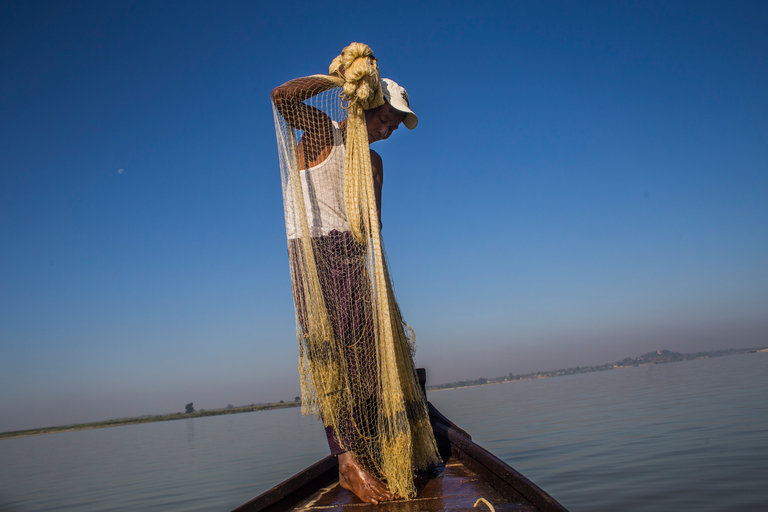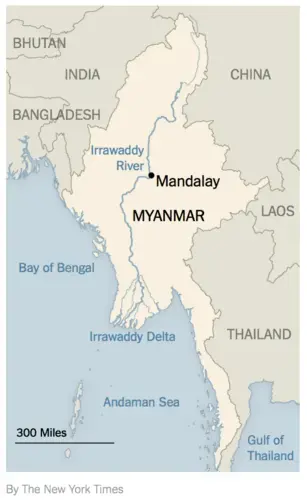
MANDALAY, Myanmar — On a recent sweltering afternoon on the Irrawaddy River, about 10 miles upstream from the city of Mandalay, a Burmese fisherman tapped a small teak dowel against the hull of his squat wooden boat, producing a xylophonic beat.
Drawn by the drumming, the gray, melon-shaped forehead of an Irrawaddy dolphin — one of maybe 65 left in their eponymous waterway — breached the surface nearby. The dolphin was joined by about a dozen more, and together they began herding a school of thrashing baitfish toward the sun-weathered fisherman, who waited on the boat with a throw net.
But before he could cast it, a barge loaded with pyramids of logs chugged past, causing the dolphins to dive and scattering the fish. Frustrated, the fisherman, U Thin Myu, began trying to drum up his partners again with the dowel. But a parade of barges from Mandalay, Myanmar’s second-largest city, motored toward him and his wife, who was rowing at the stern.
Mr. Thin Myu is one of a few dozen fishermen left in Myanmar who know how to cooperate with Irrawaddy dolphins to fill their nets. Dwindling numbers of the endangered dolphins live in freshwater rivers and bays, including in Bangladesh and Indonesia, but only the population in Myanmar has been definitively documented as cooperating with humans. It is one of the few known instances of cooperation between humans and wild animals in the world.
Irrawaddy dolphins have a long history with humans: A Chinese text dated to A.D. 800 noted, “The Pyu people traded this animal to China, and they named it the river pig.”
When the dolphins stopped being prey and became partners is not known, but Mr. Thin Myu, 44, says he thinks it started in the times of his great-grandfather, who was a fisherman as well. Mr. Thin Myu said he had learned how to fish with dolphins from his brother and uncle. Back then, he told me, the fishermen had names for every dolphin, and the dolphins were so enthusiastic that they would spit water on fishermen sleeping in their boats at night to wake them to fish before dawn.
But the cooperation has frayed in the last decade as Myanmar has emerged from a half-century of isolation under a military junta.

As the nation has modernized, the threats confronting the river dolphins have multiplied. Mercury from illegal gold mines, fertilizer from farms and industrial waste from factories have polluted the Irrawaddy. Increased ship traffic has harried the dolphins, and collisions are often fatal. Overfishing has devastated food sources, and the dolphins can get trapped in fixed gillnets and drown. Several are believed to have been electrocuted by fishermen illegally using car batteries to try to stun fish.
In 2012, the Wildlife Conservation Society reported finding 77 dolphins in the Irrawaddy. A 2016 survey found only 65. Since 2006, Myanmar’s government has established a special dolphin protective zone stretching about 50 miles north of Mandalay. But in the zone’s early years, there was little enforcement against electroshock fishing or pollution.
Recently, patrols have increased, and U Han Win, a researcher at Myanmar’s Department of Fisheries, says that dolphin conservation efforts have turned a corner. “The population decline of the dolphins would have been steeper if not for conservation,” he said. “Today, despite many challenges, the population is stable and doing better than it would have otherwise because of the conservation efforts.”
Mr. Thin Myu, the fisherman, said that the increased patrols had made a positive difference. “Because of the patrols, now there are fewer electric fishermen,” he said, “and so the dolphins are working more cooperatively with us.”
As he waited for the convoy of barges to rumble past his boat, Mr. Thin Myu patiently smoked a cheroot. After the convoy passed, he was again able to call the dolphins. He yelped at two he recognized, one by the distinctive white band around its neck, as if greeting old friends.

One of the dolphins turned upside down, lifted its tail out of the water and slapped it down hard to the right — signaling to Mr. Thin Myu the location of their prey. With a shot-putter’s twist, he cast his net. The white mesh billowed open and came down over the roiling water. Another dolphin swam behind the splashing fish, herding them into the net. As Mr. Thin Myu reeled it in, the dolphins plucked at escaping fish.
Mr. Thin Myu yanked a half-dozen small fish from the net, not yet enough for a full meal for his family. On better days, he would sell his excess catch at the market. But he never gave any to the dolphins — they had learned to cooperate with the fishermen independently, perhaps because they could steal fish tangled in the net.
As the number of dolphins has dwindled, so has the number of fishermen who know how to work with them. According to the Wildlife Conservation Society, which helps Myanmar’s government manage the cetaceans, the number of cooperative fishermen has dropped to 65 — exactly the same as the number of Irrawaddy dolphins believed to still be in the river. Most of the fishermen are older, and finding new recruits is a challenge.
Mr. Thin Myu trained his son to work with the dolphins, but the son left their village for Mandalay, so his wife now rows while he handles the net. Still, he has been tutoring five youths, trying to pass on the tradition. But with Myanmar’s economic development, he has noticed that young people find city jobs more alluring than trying to squeeze a living from the river.
The best hope to save both the dolphins and the fishermen may be ecotourism. Mr. Han Win, of the Department of Fisheries, estimated that 700 to 1,000 tourists come to see the dolphins every year. Most arrive on cruise ships and have little interest in the fishermen. But recently, the Wildlife Conservation Society and the Ministry of Livestock, Fisheries and Rural Development have begun to encourage smaller tours to accompany the fishermen, for which they are paid the equivalent of $20, a welcome sum in a country where the average worker makes $500 a month.
U Kyaw Hla Thein, a project manager for the Wildlife Conservation Society, said, “Ecotourism encourages local fishermen to move away from harmful activities like electroshock fishing and maintain their traditional lifestyles. Dolphin conservation won’t be a success without ecotourism, and ecotourism won’t be a success without conservation.”
Whether the dolphins and their partnership can endure in the face of Myanmar’s rapid modernization is unknown. Scientific study of the cooperative fishing phenomenon has been sparse.
Brian Wood, an anthropology professor at Yale University, has researched similar instances of cooperation between humans and wild honeyguide birds to harvest honey in Tanzania.
“As industrial lifestyles replace traditional ones across the world, humanity’s longstanding relationships with nature are disappearing,” Professor Wood said. “Once these relationships are lost, it’s almost impossible to get them back.”
“The dolphins’ intelligence led them to partner with us originally because of the benefits they gained from us,” he added. “As they become less cooperative, they may be concluding it is no longer in their best interest to work as our partners.”













